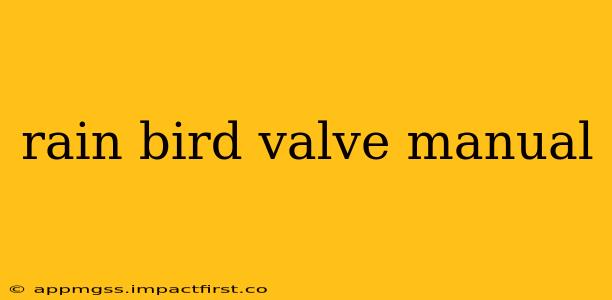Rain Bird is a leading brand in irrigation systems, known for its reliable and efficient valves. Understanding your Rain Bird valve is crucial for maintaining a healthy lawn and efficient water usage. This guide provides a comprehensive overview of Rain Bird valve manuals, covering installation, troubleshooting common problems, and regular maintenance. Whether you're a seasoned landscaper or a homeowner tackling your first irrigation project, this resource will help you get the most out of your Rain Bird system.
What Information Can I Find in a Rain Bird Valve Manual?
A Rain Bird valve manual typically contains detailed information specific to the model of valve you own. This information is vital for proper installation, operation, and maintenance. Expect to find the following:
- Detailed diagrams and schematics: These visuals aid in understanding the valve's internal components and wiring connections. This is especially helpful during installation and troubleshooting.
- Installation instructions: Step-by-step guidance on how to properly install the valve in your irrigation system, including specifics about pipe sizing, backflow preventer connection, and electrical wiring (if applicable).
- Operating instructions: Details on how to manually operate the valve, including how to test its functionality and identify any potential issues.
- Troubleshooting guide: A list of common problems and their solutions, covering issues such as low water pressure, leaks, and malfunctions.
- Maintenance procedures: Recommendations on how to regularly maintain the valve to ensure its longevity and optimal performance. This may include flushing the valve and inspecting for wear and tear.
- Parts list: A diagram and list of individual components within the valve, enabling easy identification and replacement of parts as needed.
- Specifications: Technical details about the valve, including flow rate, pressure rating, and electrical requirements.
How Do I Find My Rain Bird Valve Manual?
Accessing your Rain Bird valve manual is straightforward:
- Check the Rain Bird website: The official Rain Bird website (rainbird.com) has a comprehensive library of manuals for all their products. You'll typically need to search for your specific valve model number, which is usually found on a label on the valve itself.
- Search online: A simple web search using the valve's model number and "manual" will often yield results. Be cautious, however, and verify the source is legitimate to ensure you’re accessing the correct and updated information.
- Contact Rain Bird customer support: If you're unable to locate the manual online, contacting Rain Bird's customer support can be helpful. They can assist in identifying your valve model and providing access to the appropriate manual.
How to Troubleshoot Common Rain Bird Valve Problems
While Rain Bird valves are known for their reliability, issues can arise. Here's a breakdown of common problems and how to address them:
My Rain Bird Valve Isn't Opening:
This could be due to several factors:
- Low water pressure: Check your main water supply pressure. Insufficient pressure can prevent the valve from opening correctly.
- Electrical malfunction (for solenoid valves): If the valve is electrically operated, ensure power is reaching the valve and the solenoid is functioning correctly. Check the wiring and control box.
- Debris or sediment clogging the valve: This often requires flushing the valve or disassembling it for thorough cleaning.
- Mechanical failure: Internal parts might have worn out or broken. You may need to replace the valve or specific components.
My Rain Bird Valve is Leaking:
Leaks can indicate several issues:
- Damaged diaphragm: A faulty diaphragm can lead to leaks around the valve body. This requires valve replacement or diaphragm repair.
- Loose connections: Check all connections for tightness; leaks can occur from loose fittings.
- Worn-out O-rings or seals: Over time, these seals can wear out, causing leaks. Replacing them is often a straightforward fix.
My Rain Bird Valve is Clicking but Not Opening:
This is often indicative of a malfunctioning solenoid (for solenoid valves). The solenoid might be stuck or failing, requiring replacement.
Regular Maintenance for Your Rain Bird Valve
Regular maintenance extends the lifespan of your valve and ensures efficient operation. Follow these steps:
- Flush the valve periodically: This removes any sediment buildup that can impede proper operation.
- Inspect for leaks: Check for any signs of water leakage around the valve body and connections.
- Lubricate moving parts (as needed): Refer to your specific manual for lubrication recommendations.
- Inspect the filter (if applicable): Regularly clean or replace the filter to prevent debris from entering the valve.
By understanding the information contained within your Rain Bird valve manual and following these maintenance tips, you can ensure the smooth and efficient operation of your irrigation system for years to come. Remember, always prioritize safety when working with water and electricity. If you're unsure about any repair or maintenance procedures, consult a qualified irrigation technician.
